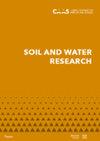使用降雨模拟器估算传统和土壤保持技术的曲线数
IF 1.7
4区 农林科学
Q4 SOIL SCIENCE
引用次数: 2
摘要
这篇文章的目的是验证《国家工程手册》(NEH)方法中给出的曲线数(CN)值,它们是否真的对应于所有宽行作物。试验作物是使用传统和土壤保护技术种植的玉米、啤酒花和土豆。所有这些作物都被归类为宽行作物,但它们在种植过程方面有很大不同。计算CN值的基础是在2014年至2020年的时间跨度内,使用降雨模拟器对对应于水文组B的土壤进行两次重复的实地测量:对应于ARC II曲线的自然干燥土壤和对应于ARC III曲线的饱和土壤。结果表明,我们计算的宽行作物常规种植的CN值原则上与NEH方法中给出的CN值相同。相反,在自然干燥土壤的情况下,表面有植物残留物的土壤保持技术存在一定差异。在免耕玉米、露地玉米和有捕获作物的啤酒花技术中可以清楚地看到较低的CN值,统计测试证实了这一点,可能是由于截留和表面粗糙度。本文章由计算机程序翻译,如有差异,请以英文原文为准。
Estimating the curve number for conventional and soil conservation technologies using a rainfall simulator
The aim of the article was to verify the curve number (CN) values given in the National Engineering Handbook (NEH) methodology, whether they really correspond to all wide-row crops. The tested crops were maize, hops and potatoes grown using conventional and soil conservation technologies. All these crops are classified as wide-row crops, but they are very different in terms of the cultivation process. The basis for the calculation of our CN values were field measurements carried out using a rainfall simulator within the time span from 2014 to 2020 on the soil corresponding to hydrological group B in two repetitions: naturally dry soil corresponding to an ARC II curve and saturated soil corresponding to an ARC III curve. The results show that our calculated CN values for the conventional cultivation of wide-row crops are, in principle, the same as the CN values given in the NEH methodology. On the contrary, a certain difference was recorded in the soil conservation technologies with plant residues on the surface, in the case of naturally dry soil. Lower CN values are clearly seen in the technologies of no-till maize, strip-till maize and hops with catch crops, which was confirmed by the statistical tests, probably due to the interception and surface roughness.
求助全文
通过发布文献求助,成功后即可免费获取论文全文。
去求助
来源期刊

Soil and Water Research
Water resources, Soil Science, Agriculture-WATER RESOURCES
CiteScore
4.60
自引率
0.00%
发文量
26
审稿时长
>12 weeks
期刊介绍:
An international peer-reviewed journal published under the auspices of the Czech Academy of Agricultural Sciences and financed by the Ministry of Agriculture of the Czech Republic. Published since 2006.
Thematic: original papers, short communications and critical reviews from all fields of science and engineering related to soil and water and their interactions in natural and man-modified landscapes, with a particular focus on agricultural land use. The fields encompassed include, but are not limited to, the basic and applied soil science, soil hydrology, irrigation and drainage of lands, hydrology, management and revitalisation of small water streams and small water reservoirs, including fishponds, soil erosion research and control, drought and flood control, wetland restoration and protection, surface and ground water protection in therms of their quantity and quality.
 求助内容:
求助内容: 应助结果提醒方式:
应助结果提醒方式:


